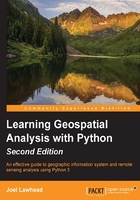
Computer-aided drafting
Computer-aided drafting (CAD) is worth mentioning, though it does not directly relate to geospatial analysis. The history of CAD system development parallels and intertwines with the history of geospatial analysis. CAD is an engineering tool used to model two- and three-dimensional objects usually for engineering and manufacturing. The primary difference between a geospatial model and CAD model is that a geospatial model is referenced to the Earth, whereas a CAD model can possibly exist in abstract space. For example, a three-dimensional blueprint of a building in a CAD system would not have a latitude or longitude, but in a GIS, the same building model would have a location on the Earth. However, over the years, CAD systems have taken on many features of GIS systems and are commonly used for smaller GIS projects. Likewise, many GIS programs can import CAD data that has been georeferenced. Traditionally, CAD tools were designed primarily for the engineering of data that was not geospatial.
However, engineers who became involved with geospatial engineering projects, such as designing a city utility electric system, would use the CAD tools that they were familiar with in order to create maps. Over time, both the GIS software evolved to import the geospatial-oriented CAD data produced by engineers, and CAD tools evolved to support geospatial data creation and better compatibility with GIS software. AutoCAD by Autodesk and ArcGIS by Esri were the leading commercial packages to develop this capability and the Geospatial Data Abstraction Library (GDAL) OGR library developers added CAD support as well.